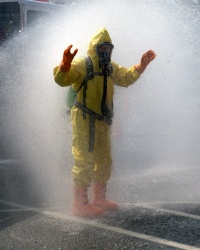
Search archive
NZ EPA and Fire Service combine forces to tackle chemical incidents
25/02/2016

Fires involving hazardous chemicals can be difficult to manage. But a new agreement with the New Zealand Environmental Protection Authority (NZ EPA) means the New Zealand Fire Service will have better support in dealing with them in future.
The below article was kindly provided by Andrea Eng, AELERT Jurisdictional Representative for New Zealand (NZ EPA).
NZ EPA and the New Zealand Fire Service (NZFS) have formalised their relationship relating to HazMat incidents through a letter of agreement.
The agreement recognises that both NZ EPA and NZFS can work together to add value and strive for excellence by collectively sharing and learning from each other, while also acknowledging that each has a legal authority or function to provide support at incidents involving hazardous substances.
History behind the agreement
Over the past two years NZFS has been consulting with partner agencies on improving HazMat advice and support. This led to the establishment of a new operating model, which has been endorsed by the National HazMat Coordination Committee (NHCC). The NHCC, chaired by the NZFS, is comprised of senior representatives from the NZ EPA, Worksafe New Zealand, New Zealand Police, the Ministry of Health, Maritime New Zealand, Civil Aviation Authority, New Zealand Defence Force, and Responsible Care New Zealand.
The NHCC meets quarterly to discuss matters relating to domestic HazMat response and provides technical specialists to the five Region Hazardous Substances Technical Liaison Committees (HSTLCs).
Letter of agreement
The letter of agreement recognises that the priority in any emergency involving hazardous substances is the need to take all reasonable practical steps to stabilise and render safe any emergency. NZ EPA, as the government agency responsible for chemical assessment and management legislation in New Zealand, has a number of staff with specific technical expertise and knowledge in dealing with hazardous substances.
As well as being represented on the NHCC, NZ EPA provides technical specialists to support the Region HSTLCs through providing over the phone technical advice on HazMat identification, instrument interpretation and treatment options for hazardous substances. This is supported by the NZFS National Hazardous Substances Advisor and the Queensland Fire and Emergency Services Scientific Branch.
NZ EPA’s Chief Executive, Dr Allan Freeth, signed the agreement with NZFS Chief Executive and National Commander, Paul Baxter, earlier this year. Dr Freeth says that the agreement means that NZ EPA’s technical expertise with hazardous substances will be more accessible to the Fire Service in the event of a HazMat emergency (an emergency involving hazardous materials).
"The preparation for such emergencies will be improved, as the two organisations will be working closely together on the Region Hazardous Substance Technical Liaison Committee and the National Hazmat Coordination Committee," he said.
Dr Freeth also confirmed that the agreement had been finalised under the NZFS’s role of coordinating government departments, local authorities, professional groups and other relevant bodies to promote fire safety.
$52,000 in dust emission fines for 4 NSW waste facilities
19/02/2016

NSW Environment Protection Authority has issued four licensed waste facilities with a total of $52,000 in fines for poor dust management practices. The fines stem from the EPA's recent "Operation Sandstorm" campaign, in which 21 Sydney waste facilities were inspected throughout November and December 2015.
The EPA has taken regulatory action against more than two thirds of the sites it inspected, and warn that the waste industry can expect more inspections. The entire operation resulted in the EPA issuing six program outcome letters, one show cause letter, four official cautions and four penalty notices. Penalty notices ranged from $7500 to $15,000, for failing to carry out operations and maintain premises in a way that minimises and prevents dust emissions. One company was also fined for failing to keep and provide records to the EPA.
Want to know more? Read the official media release.
SA's first jail sentence for illegal dumping
10/02/2016

In a landmark decision for South Australia, a forty year old man has been sentenced to four months and two weeks imprisonment for an environmental offence.
Gabriel Paul Ivanyi was convicted in the state's Environment, Resources and Development Court on 11 counts of illegal waste disposal, and one count of failing to comply with an Environmental Protection Order. He was additionally ordered to pay clean-up costs of $44,000. The imprisonment sentence has been suspended on a two year good behaviour bond.
This is the first time that a custodial sentence has been delivered in South Australia for an environmental offence.
My Ivanyi is the sole director of Adelaide Earth Removal, a company that offers services in site clean-up, site preparation, rubbish removal, demolition and concrete removal. He dumped waste on 26 seperate occassions on vacant land owned by SA Water Corporation, Australian Rail Track Corporation and the Minister for Transport and Infrastructure. The incidents occured over a period of nearly six months, and continued after a police warning. He also failed to comply with an Environment Protection Order requiring him to remove the waste.
AELERT member and EPA Manager Investigations & Tactical Support, Stephen Barry, said that Mr Ivanyi demonstrated a blatant disregard for the Environment Protection Act with a significant cost to the environment, waste disposal business and the general amenity of the dumping sites.
"These offences also undermined legitimate competitors in the salvage and disposal industry by undercutting their costs through unlawful disposal methods," Mr Barry said.
Mr Ivanyi was previously found guilty in the Port Adelaide Magistrates Court in May 2012, for illegally dumping waste in December 2011 but despite his conviction, continued to illegally dump construction waste.
The investigation timeline
This conviction follows a long and significant investigation by the Environment Protection Authority South Australia.
- 6 December 2012: EPA Investigator and AELERT Member, Anthony Williams, photographs a truck parked at Mr Ivanyi's home. The truck was full of rubbish including green laminate and timber panels.
- 7 December 2012: Investigator Williams returns to the residence and witnesses the truck, but with no rubbish inside. He then drives around the surrounding streets looking for illegal dumping. He discovers and photographs piles of demolition waste at a vacant plot, and recognises the laminate that he saw in the truck on the previous day. Subsequent searches of the dump site reveal a piece of wood with a name written on it.
- In further investigations, EPA Officers discover that the name on the piece of wood belongs to a licenced builder who hired the services of Adelaide Earth Removal. The builder uses the site photos to identify some of the dumped rubbish as originating from his site.
- Pacific National offers EPA SA footage from their security camera, which captures train movements along a line adjacent to the dumping site. The footage shows a truck depositing waste at the site on a seperate occassion on 9 December 2012.
- A series of other illegal dumping incidents at the site are investigated in a similar fashion, with staff finding envelopes with names and addresses in the waste, accessing more surveillance footage and gaining eye-witness statements. These investigations tie Mr Ivanyi to the dumping incidents.
Find out more:
- Court decision summary
- EPA SA Media Release
- ABC News story: "Adelaide man who illegally dumped construction waste handed suspended sentence"
- Yahoo 7 News story: "Jail sentence for SA man over dumping"
Wildlife Crime Tech Challenge yields innovative solutions
01/02/2016

16 clever innovations have won the recent Wildlife Crime Tech Challenge, receiving $10,000 each and technical assistance to pursue their solutions. The competition attracted more than 300 entries from 52 countries, all offering science and technology solutions to tackle wildlife trafficking issues.
We've summarised a few that particularly caught our eye!
Fake GPS turtle eggs reveal trafficking routes
USA
Poachers regularly steal sea turtle eggs from beach nests for sale on the black market. USA's Paso Pacifico team plans to create artificial eggs for four commonly targeted turtle species. The eggs, containing GPS devices, will be placed in nests that are considered poaching targets. The eggs can then be tracked and mapped, revealing trafficking routes.
Enforcement Gaps Interface (EGI)
USA
EGI uses powerful data mining and analysis to identify gaps in the enforcement of internet wildlife trade. The EGI team will build an online, password protected interface that will allow environmental law enforcers to access data from nearly 100 commercial sites for CITES Appendix I-listed fauna sites.
e-Eye
India
The "e-Eye®" is a self-learning application that provides around-the-clock wildlife surveillance. It innovatively combines software and hardware, including hi-end thermal surveillance, to create an intelligent monitoring system. The e-Eye enables the surveillance of inaccessible areas; trend analysis; intrusion detection; patrol management; and corruption prevention.
The device can identify the direction and movements of big group of animals including group density and average speed.
Tank Watch: The Good Fish / Bad Fish Tool for Saltwater Aquariums
USA
 Did you know that about 98% of fish found in saltwater tanks can't yet be bred in captivity? This means that tens of millions of coral reef fish are captured using cyanide, weakening and killing fish, corals, and other invertebrates.
Did you know that about 98% of fish found in saltwater tanks can't yet be bred in captivity? This means that tens of millions of coral reef fish are captured using cyanide, weakening and killing fish, corals, and other invertebrates.
The Tank Watch mobile app aims to increase consumer awareness by allowing people to easily identify popular aquarium species. Consumers will be able to determine whether the fish they are considering can be bred in captivity, or whether it could only have been caught in the wild.

